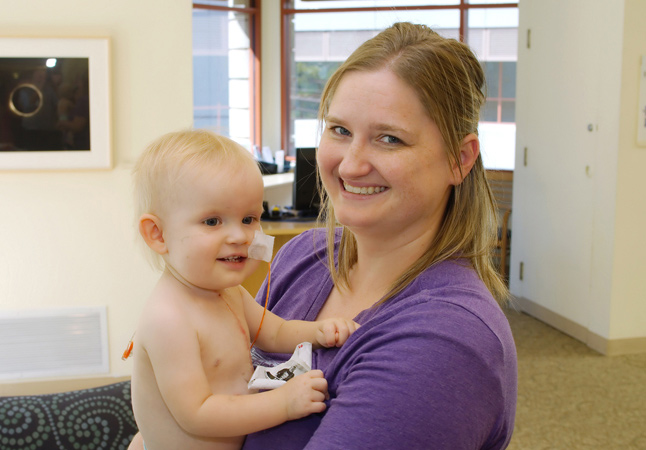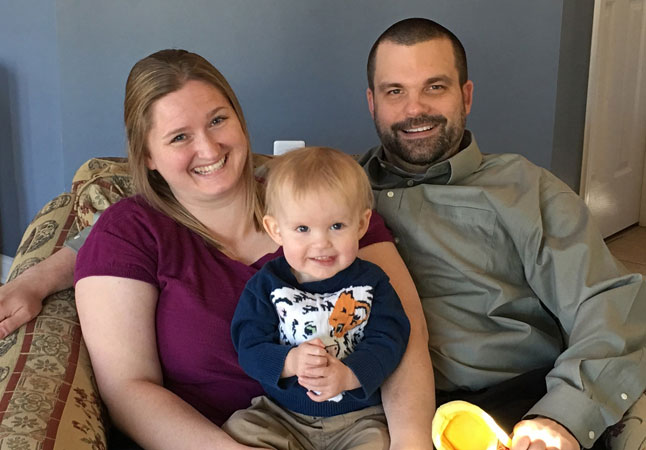Family Travels Coast-to-coast for Child’s Lifesaving Heart Surgery from Dr. Frank Hanley at Stanford Medicine Children’s Health
* Swimming lessons? Check. Banging on the piano? Check. Playing in the snow? Check. Toddler Alex Bracebridge is now living a normal life – the life his parents dreamed for him.
For Release: February 24, 2016

STANFORD, Calif. —To the casual observer, Alexander Bracebridge is just another curious, fun-loving 20-month-old. He enjoys running, throwing balls, taking swimming lessons, and playing with TV remotes. When he wants to go outside, he lets his parents know by bringing his shoes to them.
First-time parents Russ and Robyn don’t take these seemingly ordinary moments for granted. That’s because their son — and his medical history — are extraordinary. Alex was born with a rare heart condition called tetralogy of Fallot, which consists of several related defects present at birth.
This past fall, the Bracebridges traveled nearly 3,000 miles from their home in northern Virginia to Lucile Packard Children’s Hospital Stanford so that Frank Hanley, MD, could perform a complex, 12-hour surgery on Alex. Hanley, chief of pediatric cardiac surgery at the hospital’s Children’s Heart Center, has helped Alex and thousands of other children with serious heart conditions lead normal lives.

Hanley invented and perfected an innovative surgical technique called unifocalization to treat ToF. His remarkable 98 percent success rate with the procedure, which allows him to do in one marathon surgery what other surgeons would stage over months or years, has helped him build the largest program anywhere for this complex surgery. It’s a program noted by the Children’s Hospital Association for having exceptional outcomes — even while tackling the most complex cases in the country.
“We are grateful that the surgeon who pioneered unifocalization was willing to do the surgery for Alex, and we’re even more grateful that the outcome was so good,” Russ said.
The Bracebridges are just one of countless families that have traveled from around the corner and around the world so that Hanley could perform their child’s surgery. From Germany to South Africa to the Bay Area, Hanley has built a “destination program,” with the most challenging types of pediatric heart surgeries performed routinely — even those that many other centers can’t or won’t attempt.
An extreme form of ToF
ToF occurs in about 1 of every 1,000 babies because of abnormal development of the fetal heart during the first eight weeks of pregnancy. In infants like Alex with the most complex form of this condition, the blood vessels that should connect the heart to the lungs instead connect the lungs to the aorta (the body’s main artery), and the heart has a hole in the wall separating its lower chambers (ventricles).
“This extreme form of ToF occurs in about one-fifth of cases,” explained Hanley, who is also a professor of cardiothoracic surgery at the Stanford University School of Medicine.
Complex ToF also includes pulmonary atresia (a missing heart valve between the pumping chamber of the heart and the lungs) and major aortopulmonary collateral arteries (small arteries that develop to supply blood to the lungs to compensate when pulmonary circulation is underdeveloped).
This abnormal anatomy increases lung blood pressure, which can damage the lungs and prevent the body from receiving fully oxygenated blood. Hanley’s one-stage unifocalization for complex ToF corrects this problem by combining the collateral arteries into one unified, functioning pulmonary (lung) artery.
A reoperative case like Alex’s takes even more experience, skill
Alex had his first major ToF surgery at an East Coast center in late 2014 when he was 5 months old. While the procedure initially addressed some issues, follow-up tests during the next 10 months showed that Alex’s right pulmonary branch remained small, and he faced other serious problems.
The Bracebridges, who learned of Hanley and his pioneering surgical techniques from Alex’s cardiologist, thought he might be able to help. They were right.
Last October, shortly before Alex turned 16 months, Hanley performed a unifocalization to address the lingering pulmonary artery problem. He likens a pulmonary artery to an oak tree with a trunk, branches and then more branches — with the potential for blockages anywhere along the way. “Alex had blockages way out on the secondary and tertiary areas affecting both of his lungs, which we were able to correct,” he said.
Alex also had a dangerous bulge on his pulmonary artery called a “pseudo-aneurysm,” caused by high lung blood pressure, which Hanley successfully removed. “They can get larger and larger and cause fatal complications,” he explained. He also replaced the first donor heart valve that Alex received and closed a small hole in his heart.
The surgery was 12 grueling hours, with no breaks for Hanley and team. But the results were well worth it: Alex showed dramatic improvements in his pulmonary blood pressure and blood flow almost immediately. It was, Robyn said, “the best news we could have hoped for.”
While unifocalization is ideally performed by Hanley during the first few months of an infant’s life, about 30 percent of his ToF cases are reoperations like Alex’s, in which an initial surgery was performed elsewhere but serious problems remain.
“Unifocalization is more complex when these children have already had surgery, so it’s best if we have the first shot for the best outcomes — however, Alex’s result with the reoperation was very, very good,” Hanley said.
So good, in fact, that he has already successfully met several post-surgical milestones. If everything is progressing as hoped at Alex’s one-year cardiology visit, he will only need routine checkups once or twice a year.
Alex will periodically outgrow his heart valves “just like kids outgrow shoes,” Hanley explained — but the operations to replace them are simple compared with the unifocalization. And once Alex is fully grown, a replacement valve will be needed every decade or two.
Hanley’s pioneering approach is another chapter in the story of Stanford Medicine’s ongoing innovation in cardiac care. In 1968, Stanford’s Norman Shumway, MD, pioneered America’s first successful human heart transplant. It’s where the first pediatric heart-lung transplant in the country was performed. And today, Stanford is home to 20 clinical trials in pediatric cardiovascular medicine while scientists at the Stanford Cardiovascular Institute are researching the origins of congenital heart disease and pediatric heart failure.
Spreading the word
Throughout their journey, the Bracebridges have received encouragement from other parents through online and in-person congenital heart defect support groups. When Alex’s cardiologist recommended Hanley, they were able to quickly connect with parents whose children had successfully undergone surgery with him — in some cases, even after others had said nothing more could be done.
“Dr. Hanley’s name should be on the tip of everyone’s tongue when a baby is diagnosed with a complex heart problem,” Robyn said.
Now, the Bracebridges pay it forward every chance they get: Robyn even serves as a co-leader of the Washington, DC, chapter of Mended Little Hearts, a nonprofit that supports children with congenital heart defects and their families.
A bright future
Looking ahead, the Bracebridges’ experience has given them some added perspective when it comes to the hopes and dreams that all parents have for their children.
“I want him to do whatever he wants, to do sports if he wants, or be a ‘nerd’ — whatever he wants to be, as long as he’s happy,” Russ said.
Russ and Robyn’s greatest hope is for Alex to live a long, healthy, high-quality life, which they now believe is possible.
“Because of Dr. Hanley,” Robyn said, “Alex’s future is so much brighter.”
* Discover more about the pediatric heart surgery program at Lucile Packard Children's Hospital Stanford here.
Authors
Robert Dicks
(650) 497-8364
rdicks@stanfordchildrens.org
About Stanford Medicine Children's Health
Stanford Medicine Children’s Health, with Lucile Packard Children’s Hospital Stanford at its center, is the Bay Area’s largest health care system exclusively dedicated to children and expectant mothers. Our network of care includes more than 65 locations across Northern California and more than 85 locations in the U.S. Western region. Along with Stanford Health Care and the Stanford School of Medicine, we are part of Stanford Medicine, an ecosystem harnessing the potential of biomedicine through collaborative research, education, and clinical care to improve health outcomes around the world. We are a nonprofit organization committed to supporting the community through meaningful outreach programs and services and providing necessary medical care to families, regardless of their ability to pay. Discover more at stanfordchildrens.org.
Connect with us:
Download our App: